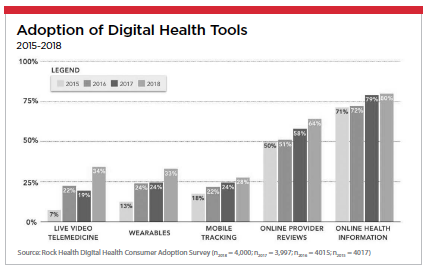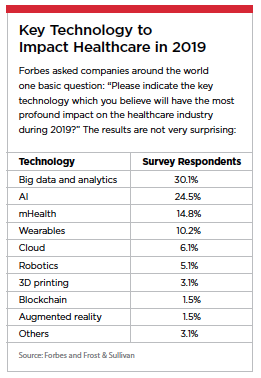The role of healthcare technology is evolving rapidly.
Changing consumer demands and habits and initiatives at a government and industry level are hastening innovation, the adoption of digital health tools, and driving technologies to reach new heights. According to a recent survey conducted by Forbes, 89% of respondents are using at least one digital health tool, such as online health information, wearables, or telemedicine.
According to a report from Zion Market Research, the global digital health market is expected to reach $423.11 billion by 2024 up from $122.66 billion in 2017. The report describes digital health as the convergence of genomic and digital technology with healthcare and society.
The plethora of disruptive technologies and innovators coming into the traditional purview of the life-sciences ecosytem is changing how medicines are discovered and how healthcare is being delivered, whether it’s through robotic surgeries, ingestible sensors, or smart pills — all of which require a shift in the patient mindset.
There is also a move toward adopting next-generation electronic or digital solutions to drive greater value in healthcare. There will be continued movement toward and adoption of artificial intelligence and machine learning to improve the management of disease and streamline processes, the use of robotics, virtual and augmented reality, incorporation of wearables and mHealth devices, as well as other breakthrough digital therapeutics and technologies.
Additionally, government-led initiatives are driving greater innovation. Under the 2009 Health Information Technology for Economic and Clinical Health Act (HITECH), the Department of Health and Human Services is spending billions to promote the adoption of health technology, all of which has helped to power an already growing digital health market.
Digital Solutions Are Driving Change
Artificial intelligence is one of the most talked about topics in any industry. In healthcare, AI is being put to use in many areas, including image analysis. AI algorithms are helping to drive greater productivity and thereby speed up image analysis for multiple purposes — from diagnosis of various forms of cancer, to cardiology, to neurology, to ophthalmology. Analysts say the objective is not to replace radiologists but rather to remove the repetitive tasks they carry out day to day and allow them to focus on diagnostic accuracy. This would ensure patients get the right diagnosis quicker.
Another digital solution that is emerging in healthcare is augmented reality (AR), which is expected to reach a value of $1.5 billion by 2020. AR is being used to provide doctors with real-time, accurate patient data, which is helping with diagnosis, treatment and surgery.
In one example, Magic Leap and Brainlab, which use spacial computing that allows patients to see and interact with digital content, are collaborating to develop programs for medical procedures, including surgery, radiotherapy, and other medical interventions.
Blockchain is another digital solution that has the potential to revolutionize the healthcare value chain. Consider the pervasive problem of drug counterfeiting and the detrimental effect this can have on patients’ health due to many counterfeits containing the wrong ingredients or the wrong level of required ingredients.
Because each blockchain transaction is immutable and timestamped, it’s easy for the supply chain to track a product and ensure information hasn’t been altered. It also allows labs to take action when there is a problem by identifying exactly where their drugs are. Blockchain also has huge potential in clinical trials by providing proof of existence of a document and proof of the authenticity of the document, which helps to ensure data can’t be altered or modified.
Robotic technologies also are playing a key role in healthcare, making medical procedures safer, delivering surgical accuracy, and preparing or dispensing medications. For example, robots are being used to examine patients in remote locations, to assist with minimally invasive surgical procedures, in helping patients with disabilities to improve mobility and strength, to transport supplies, to clean and disinfect areas after deadly infections such as Ebola, and for prescription dispensing in pharmacies.
Digital Solutions in the Patient-centric Era
There’s growing awareness across the healthcare value chain of the role that the patient plays in his or her own health. The use of medical health apps and wearables has continued  to increase, for example to manage treatment compliance and improve monitoring of patients as well as to gather insights on health trends. While the app revolution has had mixed reviews, these easy-to-use digital guides do provide patients with a way to engage in their own health in a multitude of ways. Furthermore, according to a recent survey, the use of wearables has risen from 13% in 2015 to 33% in 2018.
to increase, for example to manage treatment compliance and improve monitoring of patients as well as to gather insights on health trends. While the app revolution has had mixed reviews, these easy-to-use digital guides do provide patients with a way to engage in their own health in a multitude of ways. Furthermore, according to a recent survey, the use of wearables has risen from 13% in 2015 to 33% in 2018.
One company that is ahead of the curve for using digital solutions to drive patient-centric digital solutions is LEO Pharma, which established LEO Innovation Lab for this purpose. LEO Innovation has been working on digital apps that give people with skin conditions resources that help them with their day-to-day lives, such as nutrition advice or beauty tips for psoriasis sufferers.
Use of and demand for telemedicine services is being driven by consumer needs. According to a recent survey, 75% of consumers used at least one channel to access remote care in 2018. This is an increase from 68% the previous year. However, surprisingly it’s urban residents who are making greater use of telemedicine than their rural counterparts (80% compared with 67%).
Separate research, published in JAMA, found telemedicine is growing but most adults in the U.S. still visit their doctors in person. Where it’s growing fastest is where there is a shortage of mental health professionals, the study found.
Tools are also emerging to help address problem areas in healthcare, such as care coordination and long wait times to see the doctor. Collective Medical is a real-time care collaboration network that was established to help care teams collaborate to help vulnerable patients. The data tells the network where the patient is, the reason they are being seen, the different clinicians treating them, and how to avoid certain risk factors.
To address the pervasive problem of wait times to see a doctor, Zodoc developed an app that lets patients see doctors’ available appointment times and book online. Patients can also see verified reviews of those doctors and create reminders to stay on top of checkups and other health needs. Another patient-focused tool is Solv, which lets patients book urgent appointments and view prices of common health issues.
As demand for digital health solutions grows, so too will the types of tools, technologies and processes that emerge. Companies will need to ensure they are ahead of the curve if they are to benefit from the digital health phenomenon.(PV)
~~~~~~~~~~~~~~~~~~~~~~~~~
Key Technology to Impact Healthcare in 2019
 Forbes asked companies around the world one basic question: “Please indicate the key technology which you believe will have the most profound impact on the healthcare industry during 2019?" The results are not very surprising:
Forbes asked companies around the world one basic question: “Please indicate the key technology which you believe will have the most profound impact on the healthcare industry during 2019?" The results are not very surprising:
Technology Survey Respondents
Big data and analytics 30.1%
AI 24.5%
mHealth 14.8%
Wearables 10.2%
Cloud 6.1%
Robotics 5.1%
3D printing 3.1%
Blockchain 1.5%
Augmented reality 1.5%
Others 3.1%
Source: Forbes and Frost & Sullivan
~~~~~~~~~~~~~~~~~~~~~~~~~
Executive viewpoints
 Matt McCarty
Matt McCarty
Vice President, Digital Patient, ERT
A Holistic Health View
The evolution of smartphone capabilities has opened up a wealth of options that enable patients to manage their care in a more convenient, immediate, and personal way. From consumer IoT products driving greater health awareness, such as fitness watches and connected scales, to medical grade wearables and sensors providing constant monitoring and alerts, patients and physicians can gain a much more holistic view of their health, allowing for greater proactive management, event alerting or diagnostic support than was previously available. With the addition of telehealth, many patients’ day-to-day problems can now be resolved quickly without leaving their home. Of course, the usefulness of this real world data relies on another disruptive technology, artificial intelligence. The ability to train algorithms that can analyze large amounts of real time data and prompt the right course of action is a lot more complex than connecting Bluetooth scales to your smartphone, but both deliver value in improving patients’ health and reducing the overall cost of healthcare.
 Prakriteswar Santikary, Ph.D.
Prakriteswar Santikary, Ph.D.
VP and Global Chief Data Officer, ERT
Disruptive Technologies
The dynamic trio of cloud computing, a modern data platform, and AI is an exciting combination of emerging technologies that has the potential to disrupt all phases of clinical trials, starting from protocol design and patient recruitment all the way to patient retention and compliance, real time data collection, reporting, analytics, and drug commercialization. In addition, block chain technology and AI-enabled conversational interfaces such as chatbots and voicebots, are going to improve the quality of data collected in real time, enhance data security, and increase patient engagement. As AI and deep learning models become more explainable and transparent, they will become more mainstream in areas of patient recruitment, imaging over-read and clinical trial risk analysis. The bottom line is that the high cost of bringing a drug to market, coupled with the high rate of clinical trial failure, is not sustainable. These disruptive technologies are going to act as an enabler to revolutionize the clinical development process pipeline, from drug discovery to drug commercialization, and all steps in between.
 Anthony Costello
Anthony Costello
VP of Mobile Health,
Medidata Solutions
Virtualizing Clinical Trials
The incorporation of the patient perspective and virtualization technologies has revolutionized the clinical trial development process. Virtual trials, hybrid trials, and wearable sensors are all solutions that help improve patient engagement, enrollment, compliance, and retention all while alleviating patient burden. By virtualizing some or all aspects of a clinical trial, we are able to enhance the patient experience and accelerate the product approval process, enabling innovative therapies to get to the market faster.
Improving the Patient Experience
The virtualization of clinical trials is the most exciting disruptive technology, as it changes how trials are run. The investigator site is no longer the sole location for patients to participate, where patients have the flexibility to participate either 100% virtually or virtual for some components in a study. With the ability to capture patient data from any location, we can expand the patient pool and improve the patient experience at the same time.
 Peter Von Bartheld
Peter Von Bartheld
VP, Customer Experience,
Ogilvy Health
Representing the Whole Person
To be relevant, messages should be tailored, and what better way than to examine customer interaction data that represents the whole person. Doctors are not only HCPs, and patients are more than their illnesses — so our approach at personalizing messages needs to go deeper, and should include all behaviors to identify the person behind the label. Having data-lakes, data-pools, and data-sets that understand the motivation behind a person’s actions can influence customized design, and inform the unique, personalized messaging.
 Joe Youssef
Joe Youssef
Associate Director, Engagement Strategy,
Ogilvy Health
Eliminating Barriers
Disruptive technologies are delivering on the promise of personalized and prophylactic care. 5G, specifically, will eliminate many existing barriers to technological advancements. It will deliver faster internet speeds, reduce connection latency, and connect more devices to networks simultaneously. 5G will be the backbone of innovation across existing technologies, such as IoT, telemedicine, and AR/VR. It will democratize healthcare in areas where care is limited due to proximity and availability.
~~~~~~~~~~~~~~~~~~~~~~~~~
STATEMENT OF OWNERSHIP,
MANAGEMENT,
AND CIRCULATION
1. Publication title: PharmaVOICE
2. Publication no.: #23626
3. Filing date: September 29, 2019
4. Issue frequency: published monthly except combined issues in July/August and Nov./Dec.
5. No. of issues published annually: 10
6. Annual subscription price: US: $190.
Non-US: $360.
7. Complete mailing address of known office of publication: PharmaLinx LLC, 244 Jacobs Creek Road, Titusville, NJ 08560, Titusville, NJ 08560
8. Complete mailing address of headquarters or general business office of publisher: PharmaLinx LLC, 244 Jacobs Creek Road, Titusville, NJ 08560, Titusville, NJ 08560
9. Full names and complete mailing addresses of publisher, editor, and managing editor:
Lisa Banket, P.O. Box 327, Titusville, NJ 08560, Taren Grom, P.O. Box 327, Titusville, NJ 08560, and Denise Myshko, P.O. Box 327, Titusville, NJ 08560
10. Owner: Lisa Banket, Taren Grom, and
Marah Walsh
11. Known bondholders, mortgagees, and other security holders owning or holding 1 percent or more of total amount of bonds, mortgages, or other securities: (none)
13. Publication title: PharmaVOICE
14. Issue date for circulation data below:
September 2019
15. Extent and nature of circulation (avg. no. copies each issue during preceeding 12 months and actual no. copies of single issue published nearest to filing date, respectively). Total no. copies – 17,905 and 17,900. Individual paid/requested mail subscriptions stated on Form 3541: 17,540 and 17,570. Sales through dealers and carriers, street vendors, counter sales, and other paid or requested distribution outside USPS: 19 and 1. Total paid and/or requested circulation: 17,559 and 17,571. Nonrequested copies stated on Form 3541: 0 and 0.
Free or nominal rate distributed outside the mail: 44 and 33. Total free or nominal rate distributed: 88 and 100. Total distribution: 17,691 and 17,704. Copies not distributed: 214 and 196. Total: 17,905 and 17,900. Percent paid and/or requested circulation: 99.25 and 99.25.
16. This statement of ownership will be printed in the November/December 2019 issue of this publication.
17. I certify that all information furnished on this form is true and complete. I understand that anyone who furnishes false or misleading information on this form or who omits material or information on the form may be subject to criminal sanctions (including fines and imprisonment) and/or civil sanctions (including civil penalties).
(Signed) Marah Walsh, Founding Partner
















